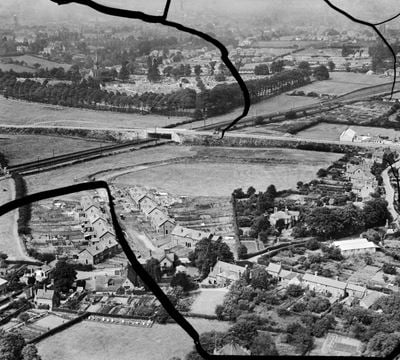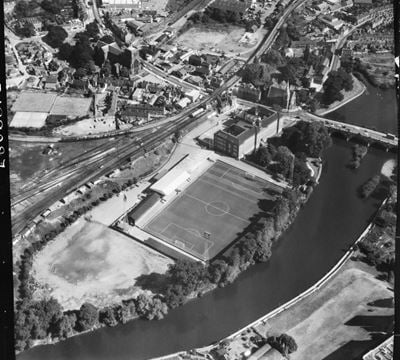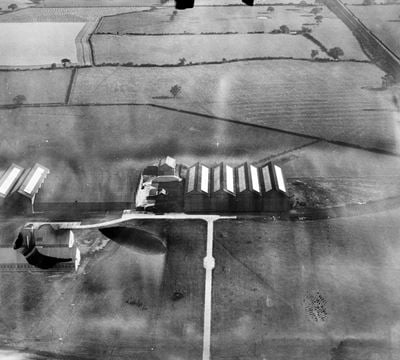Shrewsbury
Explore hidden histories, historic photos, and things you never knew about Shrewsbury from the collections and archives of Historic England.
Discover your local listed buildings and places
Introducing some of Shrewsbury's most historic sites, included in the National Heritage List for England. Some of these captions have been summarised by AI. Click through for the official List entry. Skip this section and go to place by numbers
Remains of the Old Church of St Chad
Shrewsbury
Remains of the Old Church of St Chad which comprise the chancel's south wall and the south transept's east wall, both C12, and the late-C15 Lady Chapel, the latter being altered in the C16...
Quarry Park, and Dingle Gardens Shrewsbury
Shrewsbury
Quarry Park in Shrewsbury, laid out with tree-lined walks in 1719, became a celebrated promenade visited by notable figures like Johnson and Boswell. It hosts an annual Flower Show.
Shrewsbury Flaxmill Maltings: Flax Warehouse
Shrewsbury
Warehouse of c1810. Part of a former flax mill designed by Charles Bage, and owned and operated by Marshall, Benyon and Bage.
Rowley's House and Rowley's Mansion
Shrewsbury
A pair of houses built in the late 16th and early 17th century, these buildings now contain a museum.
Shrewsbury Flaxmill Maltings: Cross Building
Shrewsbury
Heckling building of 1812 which may incorporate some late-C18 fabric; altered late C19 during conversion to a maltings.
Shrewsbury Flaxmill Maltings: Malting Kiln
Shrewsbury
Former maltings kiln, 1896-7 designed by Henry Stopes. Within a former flax mill complex that was converted to a maltings in 1897-8 and closed in 1987.
Former Her Majesty's Prison Shrewsbury
Shrewsbury
A prison complex of three conjoined wings, set within a walled enclosure, of 1788-93 by John Hiram Haycock, with assistance from Thomas Telford and John Howard, and of 1883-88 by the Prison...
Shrewsbury Flaxmill Maltings: Dyehouse and Stove House
Shrewsbury
Former Dyehouse and attached Stove House, dating from the early 1850s and pre-1810 respectively. Dyehouse altered in late C19, and Stove House enlarged and rebuilt in the 1840s.
Shrewsbury Flaxmill Maltings: Stables and remains of Pack…
Shrewsbury
Former stables, of the early C19 with minor late-C19 and mid-C20 alterations, and the remains of a packing warehouse of c1800; largely demolished in 1979.
Shrewsbury Flaxmill Maltings: Apprentice House
Shrewsbury
Former apprentice house of c1811 with late-C19 and C20 alterations.
Shropshire War Memorial
Shrewsbury
First World War memorial by George Hubbard, with sculpture by Allan Wyon, erected in 1922. Additional dedications to the Fallen of later wars added after 1945.
Remains of Bennett's Hall, 2 and 3 Pride Hill
Shrewsbury
Remains of a medieval building in the centre of Shrewsbury dating from the C13 believed to have been a merchant's house. Read the official list entry to find out more.
Shrewsbury Flaxmill Maltings: Smithy and Office
Shrewsbury
Former smithy and office, early C19 with late-C19 alterations.
Drapers Hall and Attached Raised Pavement and Railings
Shrewsbury
Drapers Hall, dated to 1560, is a timber-framed structure in Shrewsbury, featuring decorative timberwork, mullioned windows, and a raised pavement with railings.
Coleham Pumping Station
Shrewsbury
A pumping station for sewage, opened in 1901, and designed by Taylor and Santo Crimp and built by Henry Price. Read the official list entry to find out more.
Remains of the crypt or undercroft to the Old Church of S…
Shrewsbury
The buried remains of the partially demolished crypt or undercroft to the medieval Church of St ChadIt was built in the C12, probably as a substructure to support the north transept above,...
The Morris Hall with boundary wall and gate, Shrewsbury
Shrewsbury
A public hall built in 1933 to designs by W J Harris. Read the official list entry to find out more.
St Michael's Parishioners' War Memorial
Shrewsbury
A churchyard war memorial, dating from July 1921, of limestone. The monument takes the form of a sculpted Calvary set in a Gothic arch with a rectangular base and plinth.
Eagle House (formerly the Eagle Star Building)
Shrewsbury
Former insurance company office, now estate agents, built in 1940 for the Eagle Star Insurance Company; architect unknown. Read the official list entry to find out more.
Hardwick House
Shrewsbury
Hardwick House, a notable 18th-century building in Shrewsbury, features classic brickwork, distinctive Doric pilasters, and original interior elements like a unique staircase design.
19-23, St John's Hill
Shrewsbury
19-23 St John’s Hill is a 1750s terraced house terrace with distinctive segmentally-arched doorways and period features like sash windows and original interior panelling.
Explore more
Search for more listed placesShrewsbury through time
This timeline shows the first period of use for buildings and places on the National Heritage List for England, just one of the details recorded for every list entry. Click around to see how Shrewsbury changes over time. Skip this section and go to aerial photos
Early medieval AD 410 to AD 1066
This period, often associated in England with Anglo-Saxons and Vikings, saw a reduction in urban living from the Roman period and increased migration from northern Europe.
Traces of this period can be found in cemeteries, particularly in artefacts and in some of the very early churches, as this period also saw the growth of Christianity in Britain.
Medieval AD 1066 to AD 1540
This period, sometimes known as the Middle Ages, began with the Norman invasion in AD 1066. It saw a significant rise in military and defensive buildings such as castles and earthworks, as well as religious houses dominating a largely agricultural landscape.
The monarchy and Church dominated the period, which also saw the break with the Roman Catholic Church and the English reformation.
Post medieval AD 1540 to AD 1901
The Post-Medieval period brought seismic changes to life in England, with religious reformation leading to the democratization of worship and the destruction of hundreds of religious houses.
In parallel, there was a huge expansion of scientific study and enlightenment that permanently altered the nation's social structure and landscape. Industrialization and mass production lead to wider global trade, emigration, and immigration.
20th century AD 1901 to AD 2000
The 20th century saw an incredible expansion of England's transport networks, with suburban growth shadowing rapid infrastructural expansion. The establishment of state schools, hospitals, and modern technical colleges, with new architectural styles, radically changed the appearance of towns and cities.
Two catastrophic world wars and the 1918 pandemic also brought unprecedented change, altering England's built environment and social structures forever.
Early medieval AD 410 to AD 1066
This period, often associated in England with Anglo-Saxons and Vikings, saw a reduction in urban living from the Roman period and increased migration from northern Europe.
Traces of this period can be found in cemeteries, particularly in artefacts and in some of the very early churches, as this period also saw the growth of Christianity in Britain.
Medieval AD 1066 to AD 1540
This period, sometimes known as the Middle Ages, began with the Norman invasion in AD 1066. It saw a significant rise in military and defensive buildings such as castles and earthworks, as well as religious houses dominating a largely agricultural landscape.
The monarchy and Church dominated the period, which also saw the break with the Roman Catholic Church and the English reformation.
Post medieval AD 1540 to AD 1901
The Post-Medieval period brought seismic changes to life in England, with religious reformation leading to the democratization of worship and the destruction of hundreds of religious houses.
In parallel, there was a huge expansion of scientific study and enlightenment that permanently altered the nation's social structure and landscape. Industrialization and mass production lead to wider global trade, emigration, and immigration.
20th century AD 1901 to AD 2000
The 20th century saw an incredible expansion of England's transport networks, with suburban growth shadowing rapid infrastructural expansion. The establishment of state schools, hospitals, and modern technical colleges, with new architectural styles, radically changed the appearance of towns and cities.
Two catastrophic world wars and the 1918 pandemic also brought unprecedented change, altering England's built environment and social structures forever.
Aerial photos of Shrewsbury
Aerial photography helps reveal secrets of England's changing landscapes that are impossible to see from the ground. Skip this section and go to archive images

Meole Brace
Housing under construction along Meole Crescent with Shrewsbury in the distance, Meole Brace, 1934

Meole Brace
Housing under construction along Meole Crescent, Meole Brace, 1934

Shrewsbury
English Bridge under construction, Shrewsbury, 1927

Shrewsbury
Gay Meadow Stadium, former home of Shrewsbury Town Football Club, Shrewsbury, 1969

Harlescott
Site of RAF Harlescott Military Supply (Motor Transport) Depot, Harlescott, 1936

Harlescott
Site of RAF Harlescott Military Supply (Motor Transport) Depot, Harlescott, 1936

Harlescott
The Chatwood Safe Co, Harlescott, 1928

Harlescott
The Chatwood Safe Company Works and housing at Harlescott Crescent, Harlescott, 1946

Shrewsbury
The town centre, Shrewsbury, 1932

Shrewsbury
The River Severn in flood, Shrewsbury, 1948
Shrewsbury in the Historic England Archive
The Historic England Archive cares for over 15 million images, dating from the 1850s to the present day. Discover stunning images of Shrewsbury's past. Skip this section and go to stories about heritage
Charles George Harper Collection
Shropshire
Date created: 1892 - 1933
Looking up Wyle Cop, with the Lion Hotel on the left and the tower and spire of St Alkmund's Church in the background
Eric de Mare
Shropshire
Date created: 1945 - 1980
General view of the English Bridge in Shrewsbury from the river bank.
John Gay Collection: Counties
Shropshire
Date created: 1940s - 1950s
An elderly woman seated by a crate of eggs in a bustling market hall in Shropshire.
John Laing Collection
Shropshire
Date created: 17 Sep 1992
The interior of the coffee shop at the newly completed Safeway supermarket in Shrewsbury.
London, Midland and Scottish Railway Company
Kingsland, Shropshire
Date created: 14 Aug 1933
The east side of Kingsland Bridge viewed from the north bank of the River Severn
Alfred Newton and Sons
Shrewsbury, Shropshire
Date created: 1896 - 1920
The former refectory pulpit of Shrewsbury Abbey, the Abbey of the Holy Cross
Nigel Temple Collection of Postcards of Parks and Gardens
Quarry Park, Shropshire
Date created: 1930 - 1960
GENERAL VIEW
Eric de Mare
Shropshire
Date created: 1945 - 1980
Detail view of the English Bridge in Shrewsbury showing a sculpture at the base of the first arch.
John Gay Collection: Counties
Shropshire
Date created: 1940s - 1950s
An elderly woman seated by a crate of eggs in a bustling market hall in Shropshire.
John Laing Collection
Shropshire
Date created: 28 Sep 1992
The Safeway supermarket in Shrewsbury from the north west with the petrol station in the foreground
London, Midland and Scottish Railway Company
Kingsland, Shropshire
Date created: 14 Aug 1933
A view looking across the River Severn at the Pengwern Boathouse
Nigel Temple Collection of Postcards of Parks and Gardens
Quarry Park, Shropshire
Date created: 1900 - 1908
GENERAL VIEW
Stories about heritage in your local area
Historic England publishes news, blogs, research, videos, and podcasts celebrating England's rich heritage. Discover the stories we have about Shrewsbury. Skip this section and go to education
The Timeless Charm of English Market Towns and Halls
Mentions The Butter Market
Discover the history of English market towns and halls, including farmers' markets, Christmas markets, market squares and corn exchanges.
What Is the Oldest Pub or Inn in England?
Mentions 71, 72 and 73, Wyle Cop
Many pubs and inns claim to be the oldest pub in England. Here are the facts.
5 Significant Historic Sites in Shropshire
Mentions Former Her Majesty's Prison Shrewsbury, Quarry Park, and Dingle Gardens Shrewsbury
Much of Shropshire has connections to influential events on the national and global stage and many offer unusual heritage stories.
5 Reasons to Love Historic Shropshire
Mentions The Mount
From the Iron Age to the Industrial revolution, Shropshire is rich with remnants from history.
The first skyscraper: Shrewsbury Flaxmill Maltings
Mentions Shrewsbury Flaxmill Maltings: Spinning Mill, Shrewsbury Flaxmill Maltings: Malting Kiln, Shrewsbury Flaxmill Maltings: Smithy and Office
A rare survival from a dramatic stage in the Industrial Revolution, Shrewsbury Flaxmill was built during a period of innovation and social upheaval.
Mentions Shrewsbury
Completed in 1220, St Mary the Virgin’s Church is a grand Norman build that sits at the heart of Shrewsbury town centre.
Repairing St Mary the Virgin’s Church in Shrewsbury
Completed in 1220, St Mary the Virgin’s Church is a grand Norman build that sits at the heart of Shrewsbury town centre. It boasts an incredible ornate nave roof, grand pinnacles and one of the finest stained-glass collections in the country.
Mentions Shrewsbury
Known as the grandparent of the skyscraper, Shrewsbury Flaxmill Maltings is home to the first iron-framed building in the world.
Restoring Shrewsbury Flaxmill Maltings
Known as the grandparent of the skyscraper, Shrewsbury Flaxmill Maltings is home to the first iron-framed building in the world. Having been derelict since its closure in 1987, the site is now being renovated into a visitor centre and office space.
Duncan Wilson, Chief Executive at Historic England, Announces Retirement and Recruitment Starts for His Successor
Mentions Shrewsbury
Duncan Wilson CBE has announced that he will retire in October this year. Historic England is now recruiting for his successor.
New Tenants at Shrewsbury Flaxmill Maltings
Mentions Shrewsbury Flaxmill Maltings: Spinning Mill, Shrewsbury
A loss adjustment and claim management company is the latest business to take offices at the multi-award-winning Shrewsbury Flaxmill Maltings.
Simulation Models and Energy Efficiency in Historic Buildings
Mentions Shrewsbury
Article exploring the usefulness of building simulation models for understanding the energy-efficiency performance of historic buildings.
Filling in the Retrofit Gaps
Mentions Shrewsbury
A new report highlights research into the energy efficiency and performance of traditional buildings and the research gaps that still exist.
Her Majesty The Queen Visits Shrewsbury Flaxmill Maltings
Mentions Shrewsbury Flaxmill Maltings: Spinning Mill, Shrewsbury Flaxmill Maltings: Malting Kiln, Shrewsbury
Queen Camilla visited Shrewsbury Flaxmill Maltings as part of a wider visit to Shrewsbury.
‘Grandparent of Skyscrapers’ Shrewsbury Flaxmill Maltings Opens
Mentions Shrewsbury Flaxmill Maltings: Spinning Mill, Shrewsbury Flaxmill Maltings: Malting Kiln, Shrewsbury Flaxmill Maltings: Smithy and Office
Shrewsbury Flaxmill Maltings opens to the public following £28 million, eight-year restoration programme, as a new visitor destination and workplace.
Heritage and Craft Workers Across England Given a Helping Hand
Mentions Shrewsbury
142 historic sites across England are receiving grants worth £35 million through the government’s Culture Recovery Fund.
England’s Heritage Worth £31 Billion To Economy Reveals New Report
Mentions Shrewsbury
New research shows the value of heritage to England’s economy which contributes to economic prosperity and growth.
HemingwayDesign commissioned to reimagine Shrewsbury Flaxmill Maltings
Mentions Shrewsbury
HemingwayDesign commissioned to reimagine Shrewsbury Flaxmill Maltings
‘As Shadows Return’ Light Installation Brings History to Life at Shrewsbury Flaxmill Maltings
Mentions Shrewsbury Flaxmill Maltings: Spinning Mill, Shrewsbury Flaxmill Maltings: Malting Kiln, Shrewsbury
Art installation marks completion of the first phase of restoration at the world’s oldest iron-framed building.
Restoration Milestone Reached for ‘Most Important Building of the Modern Age’
Mentions Shrewsbury
Restoration of the roof completed on the 1797 Grade I listed Main Mill at Shrewsbury Flaxmill Maltings.
Remembering Passchendaele: War Memorials Listed
Mentions Shropshire War Memorial, Shrewsbury
Battle of Passchendaele centenary marked with 13 new and upgraded war memorial listings
Shrewsbury's social history through photos
Over 10,000 images from the Historic England Archive have been specially selected and re-captioned for teachers, students, and anyone who wants to learn more about their local area. Skip this section and go to grant-aided places
Wyle Cop, Shrewsbury, Shropshire
Period: Victorian (1837 - 1901)
Looking south down Wyle Cop, towards numbers 70-73.
Wyle Cop, Shrewsbury, Shropshire
Watch Tower, Shrewsbury, Shropshire
Period: Medieval (Middle Ages) (1066 - 1484)
This Watch Tower was built in the 13th century. It was built as part of the Town Walls. It has arrow slit windows.
Watch Tower, Shrewsbury, Shropshire
Town Wall, Shrewsbury, Shropshire
Period: Medieval (Middle Ages) (1066 - 1484)
These fragments of Town Wall were built in c1226. They are part of what was known as the Great Wall of Henry III (1220-1252).
Town Wall, Shrewsbury, Shropshire
The Old Porch House, Shrewsbury, Shropshire
Period: Stuart (1603 - 1713)
This timber framed house is dated 1628. Architectural evidence however suggests that the house is probably older than this date.
The Old Porch House, Shrewsbury, Shropshire
Tags
The Old Police House, Shrewsbury, Shropshire
Period: Georgian (1714 - 1836)
This house was built in the early 1700s. The cellars of the house incorporate the remains of cells from its earlier use as a courthouse and gaol.
The Old Police House, Shrewsbury, Shropshire
Tags
The King's Head, Shrewsbury, Shropshire
Period: Tudor (1485 - 1602)
This is a three-storey timber framed building. Its timbers have been dated to c1404.
The King's Head, Shrewsbury, Shropshire
The Abbot's House, Shrewsbury, Shropshire
Period: Tudor (1485 - 1602)
This is a remarkably complete and significant surviving example of a late medieval town house, with evidence for original shop units.
The Abbot's House, Shrewsbury, Shropshire
Statue of Charles Darwin, Shrewsbury, Shropshire
Period: Victorian (1837 - 1901)
This statue of Charles Darwin was built in 1897. Charles Robert Darwin was born on the 12th of February 1809, in Shrewsbury, Shropshire.
Statue of Charles Darwin, Shrewsbury, Shropshire
Tags
Discover more
Ready for more local heritage? Take a look at these other places nearby


